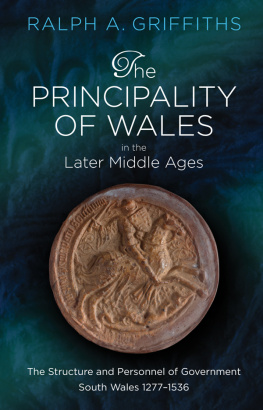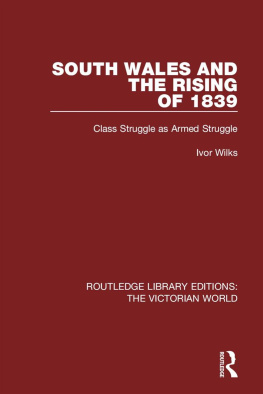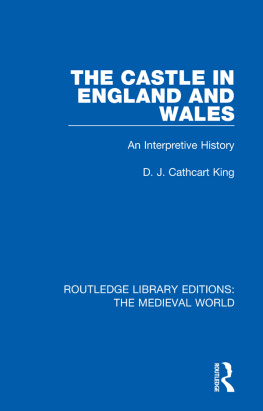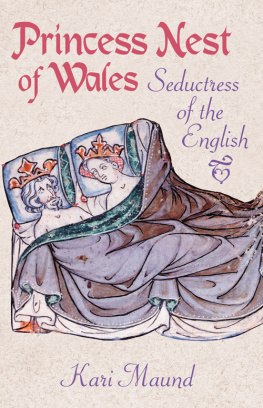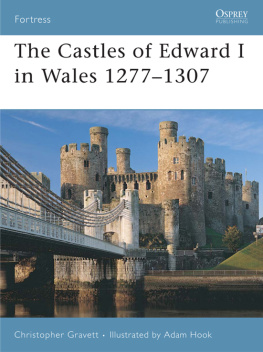First published by the University of Wales Press in 1972, for the
University of Wales Board of Celtic Studies (History and Law series, vol. 26).
Ralph A. Griffiths, 2018
All rights reserved. No part of this book may be reproduced in any material form (including photocopying or storing it in any medium by electronic means and whether or not transiently or incidentally to some other use of this publication) without the written permission of the copyright owner. Applications for the copyright owners written permission to reproduce any part of this publication should be addressed to The University of Wales Press, 10 Columbus Walk, Brigantine Place, Cardiff CF10 4UP.
www.uwp.co.uk
British Library Cataloguing-in-Publication Data
A catalogue record for this book is available from the British Library.
ISBN 978-1-78683-264-1
eISBN 978-1-78683-266-5
Rights of authorship for this work have been asserted in accordance with
sections 77 and 79 of the Copyright, Designs and Patents Act 1988.
The publisher has no responsibility for the persistence or accuracy of URLs for any external or third-party internet websites referred to in this book, and does not guarantee that any content on such websites is, or will remain, accurate or appropriate.
Cover image: Henry Vs seal (1422) of the Principality in South Wales (Penrice & Margam No. 244, National Library of Wales).
Cover design: Olwen Fowler
IN MEMORY OF
MY PARENTS
MARION LOVIN GRIFFITHS AND
THOMAS ROWLAND GRIFFITHS
PREFACE
T HIS book is a contribution to the study of the principality of Wales in the later middle ages. It deals with the two royal shires in south Wales, Carmarthenshire and Cardiganshire, which together came to be known conveniently (though not with constitutional propriety) as the principality of south Wales, and with those people, both great and small, who administered these shires during the two and a half centuries following the Edwardian Conquest of Wales.
A large part of the volume is a calendar of the royal officers of south Wales: more than a mere list, it is a chronological arrangement of biographical notes illustrating the personnel of each office, both central and local. Where an officer performed his duties by deputy, the deputys note is indented beneath that of his superior. These biographical notes do not claim to be exhaustive; the intention is simply to indicate wherever possible the kind of person (in terms of family background, geographical origins, public career, wealth and experience) to be employed in principality administration between the Edwardian Conquest and the reorganisation of Welsh government by Henry VIII. For this purpose, the more important and accessible sources have been consulted as well as, in the case of unpublished material, some that are less easily available. The financial records of government (especially the numerous Ministers Accounts) identify many of the officials, and hence their term of office in the Calendar coincides with the mediaeval financial year, from M[ichaelmas] to M[ichaelmas]. Official appointments enrolled by the royal Chancery survive in profusion, and yet others have been culled from less predictable sources in truly magpie fashion. Inevitably the choice of source material for the biographical notes has been selective, dependent on the authors knowledge, the resources of the libraries he has been able to use, and the limitations of road, rail and time. Where adequate biographical notes are already easily available in print, these have been indicated, while the additional information which has sometimes been added to them refers primarily to Wales. Biographical notes hidden away in unpublished theses have been summarised. In a work of such detail there will be omissions to be remedied and errors to be corrected; the author will be grateful for notice of both.
In compiling the biographical notes, it was felt that connected, grammatical prose was preferable to a series of disjointed phrases and, secondly, that it would facilitate the verification of statements if references were placed in the appropriate place in the body of each note rather than in an amalgamated footnote at its end. This has undoubtedly lengthened the notes and perhaps made them less easy to read, but the virtues of this method of presentation seemed to outweigh its disadvantages. Cross references posed a problem. It was thought best that the first mention of an officer in the Calendar should carry his full biographical note and that subsequent appearances of the same officer should be accompanied by a simple cross reference to the earlier, fuller note. Unpublished material in the Public Record Office and British Museum, London, and in the National Library of Wales, Aberystwyth, is not distinguished in the notes by the name of the repository, but a complete tally of the collections consulted in each of these institutions (with the respective abbreviation used in the Calendar) has been provided. Local record offices, however, are specifically noted in the text. The abbreviations used are intended to illuminate rather than to mystify: many of them are self-explanatory and the others can be understood by referring to the list of abbreviations. The only concession to economy which the reader might find irritating is the absence of the abbreviatory stop and the occasional oddity that results, e.g., Corn for Cornwall!
Modern Welsh orthography has been adopted in the spelling of Welsh personal names, except where they are known to have an English form in general use among historians (e.g., the Vaughans of Brecknock). I have also had to standardise where contemporaries showed considerable variation (e.g., Gruffydd instead of Griffith, Griffin, etc.); where there was contemporary consistency in the use of more than one form, the distinction has been retained (e.g., between William and Gwilym). Adjectival mutations present a problem to modern scholars, let alone to medievalists, and so I have retained the contemporary form even though this has produced some inconsistencies (e.g., both Du and Ddu put in an appearance). In spelling place names, I have employed the modern Welsh form as indicated by Elwyn Davies (ed.), A Gazeteer of Welsh Place-Names (3rd. ed., Cardiff, 1967), or Melville Richards, Welsh Administrative and Territorial Units, Medieval and Modern (Cardiff, 1969). The exceptions include well known place names with Anglicised forms in general use (e.g., Kidwelly rather than Cydweli, Cardiff instead of Caerdydd). Above all, common sense and consistency have been my guide.
My interest was first drawn to the late-medieval principality by my friend Mr. T. B. Pugh, who has generously answered my queries ever since. I am also deeply grateful to my supervisor and friend Dr. Margaret Sharp, who carefully guided my first steps in investigating a problem which her father, Professor Tout, never had an opportunity of tackling in his magisterial study of English government. As an expansion of earlier work, this volume was commissioned in 1961 by the History and Law Committee of the Board of Celtic Studies of the University of Wales: it has been a long time a-writing. In 1968 the Committee assigned one of its research assistants, my former pupil Mr. (now Dr.) Roger S. Thomas, to the project and his help has made the publication of the volume possible now. My greatest immediate debt is to Dr. Thomas, who extended my own work on the

